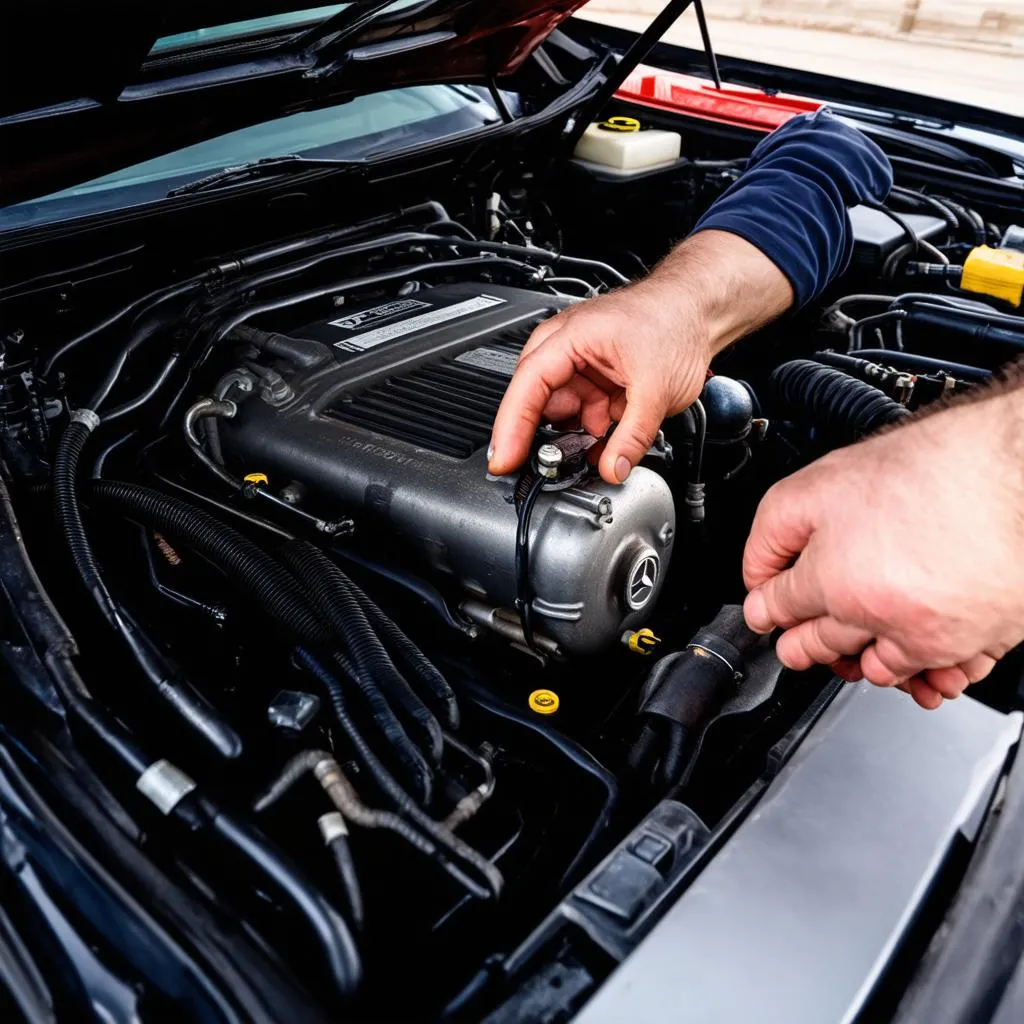A malfunctioning seat belt buckle in your Mercedes can be a frustrating and potentially dangerous issue. Whether it’s sticking, jammed, or simply not latching, understanding the common causes and fixes can save you time and money. This comprehensive guide will walk you through the steps to diagnose and potentially repair your Mercedes seat belt buckle.
Understanding the Problem
Common Causes of Seat Belt Buckle Problems in Mercedes
Several factors can contribute to a faulty seat belt buckle in your Mercedes:
- Dirt and Debris: Over time, dust, crumbs, and other debris can accumulate inside the buckle mechanism, preventing it from engaging properly.
- Worn-out Components: Like any mechanical part, the internal components of the buckle, such as springs and release buttons, can wear down with use.
- Bent or Damaged Buckle Tongue: If the metal tongue of the seat belt is bent or damaged, it might not fit correctly into the buckle.
- Faulty Wiring: In some cases, a problem with the electrical wiring connected to the seat belt system, such as a loose connection or a blown fuse, can also prevent the buckle from functioning properly.
Recognizing the Signs of a Faulty Seat Belt Buckle
Identifying the signs of a problematic seat belt buckle early on is crucial for safety:
- Difficulty Latching or Releasing: If you struggle to buckle or unbuckle your seat belt, it’s a clear indicator of a problem.
- Loose Buckle: A loose buckle that doesn’t hold the seat belt securely in place is a serious safety concern.
- Warning Lights: A persistent seat belt warning light on your dashboard, even when the seat belt is fastened, could signal a buckle malfunction.
mercedes-seat-belt-warning-light|Dashboard Warning Light|Close-up image of a Mercedes dashboard illuminated with a red seat belt warning light.
Diagnosing the Issue
Before attempting any repairs, it’s crucial to determine the root cause of the problem. Here’s a simple checklist:
- Visual Inspection: Carefully examine the buckle and the surrounding area for any visible signs of damage, debris, or foreign objects.
- Cleaning: Use a vacuum cleaner with a crevice attachment or compressed air to remove dirt and debris from inside the buckle mechanism.
- Testing the Mechanism: Gently insert and remove the seat belt tongue several times to see if the buckle engages and releases smoothly.
- Checking for Loose Connections: If you suspect a wiring issue, inspect the connections around the buckle for any loose or damaged wires.
cleaning-mercedes-seat-belt-buckle|Cleaning Seat Belt Buckle|Close-up image of a person using a small brush to clean dirt and debris from inside a Mercedes seat belt buckle.
Gathering the Necessary Tools
Before you begin any repairs, it’s helpful to gather the following tools:
- Torx Screwdriver Set: Mercedes often uses Torx screws to secure interior components.
- Flathead Screwdriver: Useful for prying open plastic covers or releasing clips.
- Needle-nose Pliers: Ideal for gripping and manipulating small parts.
- Vacuum Cleaner or Compressed Air: For thorough cleaning.
- Electrical Tape (optional): For securing loose wires if necessary.
tools-for-seat-belt-repair|Tools for Repair|Image of a workbench with an assortment of tools laid out, including a Torx screwdriver set, flathead screwdriver, needle-nose pliers, and electrical tape.
Fixing a Mercedes Seat Belt Buckle: A Step-by-Step Guide
Disclaimer: While this guide provides general instructions, the specific repair procedures may vary slightly depending on the model year and trim level of your Mercedes. Always consult your owner’s manual or seek professional assistance if you’re unsure about any step.
Step 1: Disconnect the Battery
Before working on any electrical components, it’s crucial to disconnect the negative terminal of your Mercedes’ battery to prevent electrical shocks or damage.
Step 2: Access the Seat Belt Buckle
Locate the screws or bolts securing the seat belt buckle to the seat or center console. Carefully remove them using the appropriate screwdriver.
Step 3: Inspect and Clean the Buckle
Once you have access to the buckle, visually inspect it again for any visible damage or obstructions. Use a vacuum cleaner or compressed air to thoroughly clean the buckle mechanism.
Step 4: Address Specific Issues
- For jammed buckles: If the buckle is jammed with debris, carefully try to dislodge it using a small, blunt tool.
- For worn-out components: If you identify worn-out parts, such as a broken spring, you might need to replace the entire buckle assembly. Consider purchasing a replacement buckle designed for your specific Mercedes model.
- For bent or damaged tongues: If the seat belt tongue is bent, gently try to straighten it using pliers. If it’s severely damaged, you’ll likely need to replace it.
Step 5: Reassemble and Test
Once you’ve addressed the issue, reassemble the buckle in reverse order, ensuring all screws and connections are secure. Reconnect the battery and test the buckle several times to ensure it latches and releases smoothly.
Frequently Asked Questions
Q: Can I use a universal seat belt buckle in my Mercedes?
A: While universal buckles might seem tempting, it’s generally not recommended to use them in your Mercedes. Seat belt systems are designed to meet specific safety standards, and using incompatible parts could compromise your safety in an accident.
Q: My seat belt warning light is still on after fixing the buckle. What should I do?
A: If the warning light persists after addressing the buckle issue, there might be a problem with the seat belt pretensioner system or the wiring. It’s best to have a qualified technician diagnose the problem using a professional diagnostic tool, such as those offered by Cardiagtech.
Q: How often should I have my Mercedes seat belts inspected by a professional?
A: It’s a good practice to have your seat belts inspected by a qualified mechanic at least once a year or as part of your regular vehicle maintenance. Regular inspections can help identify potential issues early on, ensuring your safety on the road.
Expert Insight: “Many people overlook the importance of regular seat belt maintenance,” says automotive expert Dr. Emily Carter, author of “The Complete Car Care Guide.” “A properly functioning seat belt is your first line of defense in an accident. Regular inspections and timely repairs are crucial for your safety.”
Conclusion
Addressing a faulty seat belt buckle in your Mercedes is essential for your safety and the safety of your passengers. By following these steps, you can potentially diagnose and repair minor buckle problems. However, for complex issues or if you’re unsure about any aspect of the repair, it’s always best to seek assistance from a qualified Mercedes technician or use professional diagnostic equipment like those provided by CARDIAGTECH.


